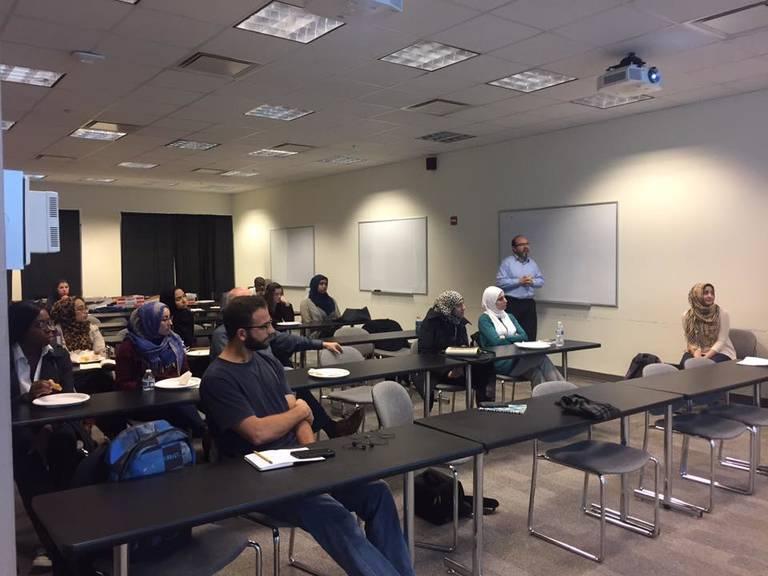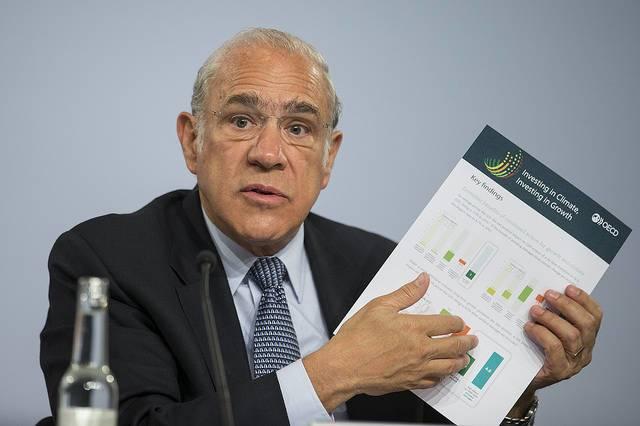Spirit of Ramadan Guides BRIDGE America to Help Refugees Adapt to a New Life


Ramadan, a month during which Muslims fast, pray, reflect and celebrate, starts today. This holy month is one of the five pillars of Islam, which also includes zakat, the obligatory giving of alms to those in need. While it is not an official pillar of Islam, hard work is also an important tenet of the religion – most Muslim countries have a 5.5 or 6-day workweek.
One grassroots organization quickly grew with that spirit of helping one’s neighbor and hard work in mind. And with its dedication to helping refugees, it continues to engage more community organizations and businesses that are opening hearts, homes and opportunities.
BRIDGE America (Betterment of Refugees through Integration, Development, Guidance and Empowerment in America) is an initiative focused on assisting refugees in the mid-Atlantic region, mostly in Delaware, Maryland, Virginia and Washington, D.C. The vast majority of the refugees it serves are from Syria, but families from Sudan, Ethiopia, Somalia and Afghanistan also receive assistance.
BRIDGE is not a government agency, nor does it receive any public funds. Neither is it a nonprofit; donations of time and resources are mostly provided by local community groups. It has no website; most of BRIDGE’s external communications are conducted via its Facebook page. Run entirely by volunteers, BRIDGE pools the resources of mosques, churches, synagogues, medical professionals, nonprofits and local businesses that share the same goal: welcoming refugee families to the U.S. and giving them a hand up, not a handout.
Services this virtual social enterprise offer include youth programs, professional mentorship, English-language education, women’s empowerment programs, job training and placement, housing assistance, and car donations.
This organization is an example of how citizens can band together, forget about seeking recognition or sporting job titles, and provide resources to cope with a problem that once was the focal point for the world’s media -- but over the past year has largely been forgotten. The number of Syrian refugees alone continues to increase: As estimated by the United Nations, almost 5 million citizens in total have fled the country.
Founded in late 2015, a year ago BRIDGE assisted three families. It now works with 185. TriplePundit spoke with Khaled Balajem, who co-founded the group and helps it focus on the core areas of support crucial for newly arrived refugee families.
Balajem himself is an immigrant; originally from Yemen, he knows firsthand the struggles of adapting to a new country. “I came here without an education, but worked hard, held multiple jobs, went to school and supported my family,” he told 3p.
Now, Balajem, BRIDGE and their allies are paying it forward. All of the progress the group is achieving has been at the community level. BRIDGE volunteers meet with families to learn what their challenges are. Local religious and non-profits then function together as an information clearinghouse to match services to refugees’ needs. “BRIDGE connects the dots and helps in providing resources,” Balajem said.
As BRIDGE supports even more families, Balajem has acknowledged that there is some talk of becoming an official certified 501(c)(3), which would allow donors to write off donations on their taxes.
But from Balajem’s point of view, BRIDGE’s structure – even if to some observers, actually shows a lack thereof – allows the initiative to thrive. “The success and the vision we have show that we can accomplish a lot without becoming an official organization,” he explained.
The beauty of BRIDGE’s efforts, Balajem says, is that the group is truly a community effort – not simply one demographic helping folks with the same experiences and background as them. “We partner with local churches that have not only been willing to help, but say they feel obliged to help refugees,” he told us, “and the huge participation with non-Muslims has been key to our success, as they have been extremely generous to this cause.”
Balajem explained that for many new arrivals, one of the first pressing needs is health care. As anyone who has been sick abroad can understand, becoming ill in an area when your local language skills are lacking makes an uncomfortable situation even more unbearable. The families BRIDGE has assisted have benefited from the medical professionals’ assistance from organizations, including the Wilmer Eye Institute at Johns Hopkins University in Baltimore. Other professionals include internists, oncologists and dentists. Many of these professionals contribute as many as 20 to 40 hours a month to consult, educate and offer resources to families.
Where BRIDGE could use more help is on the employment front. One of the first things for which these families ask is job security. Balajem noted that in his adopted home state of Maryland, its proximity to D.C. contributes to the high cost of living. Language barriers are a hurdle to securing jobs in the highly specialized fields within which many of these refugees worked before they fled their homelands.
To that end, BRIDGE is working with community organizations to help businesses match their needs with these new arrivals’ skills. Other businesses have reached out and expressed interest in hiring former refugees. But this process is an uphill climb, Balajem explained. He spoke of one man, who used to be a successful pastry chef in Syria. “Now this man is washing cars, as he has a family to support, and like other families in this network, they do not want to rely on social welfare,” he said.
One company offering support in a way that reflects the spirit of Ramadan is a food import business in Vienna, Virgina. Sahara Date Co. was founded by two cousins, Maile Ramzi and Jean Houpert.
Ramzi’s passion for dates was sparked while she was an expatriate in Saudi Arabia with her Egyptian husband. Upon moving back to the U.S., Ramzi found U.S.-grown dates not quite comparable to those she enjoyed in the Middle East. A few years ago, the cousins began sourcing dates from what they say are some of the oldest farms in the Arabian Peninsula, and now their business supplies retail chains including Whole Foods and Harris Teeter.
Ramzi and Houpert were impressed when they were introduced to Balajem as he and BRIDGE's co-founders launched the organization, and they wanted to help.
The company has partnered with BRIDGE for two years to spread some cheer and hope during Ramadan. The company donated dates to all the families receiving assistance from BRIDGE. Muslims generally break the daily Ramadan fast with a few dates as they begin Iftar, the evening meal timed at sunset. Dates have also long been important to Middle Eastern cuisine and culture; visit someone's home, an office or a hotel in the region, and dates along with Arabic coffee are quickly offered.
Ramzi and Houpert have met many of the families that have received support from BRIDGE. “My husband is an immigrant. I am the daughter of immigrants, and we are all immigrants depending on how far you want to go back,” Ramzi told us. “These people are role models for all of us, as they know what it means to overcome adversity and keep hope and love alive in your heart.”
Whether BRIDGE is matching jobs to head of households, or Sahara Date is offering an expression of Ramadan warmth and hospitality, Ramzi says the bottom line is what it means during this time of year to offer a hand to those in need.
“When we offer dates, we’re saying, 'We welcome you, and we are happy you are here,'” she explained. “But we also say: 'We acknowledge what you have endured -- your tremendous suffering and loss -- and we share a common humanity. We wish you all the best in finding a better life here, and we want to help in some small way.'”
Image credits: Sahara Date Company; BRIDGE America
OECD: Climate Action Can Boost World’s Economy By 5 Percent


Assertive climate action investment can help boost global economic output, the Organization of Economic Cooperation and Development (OECD) argued in a new report.
In the foreward of the 309-page study, the OECD argues: “Improving productivity and reducing inequalities need not come at the expense of locking the world into a high-emissions future. It is the quality of growth that matters.”
Buttressed by an extensive number of tables, government data and summaries of nations’ climate and energy plans, the OECD recommends several big-ticket measures, including a carbon tax, massive investments in infrastructure and increased financing for low-carbon technologies.
The OECD’s 70-year track record of supporting the case for market-driven helps support the argument that more sustainable development does not have to come at the expense of economic growth. Other global organizations that tout the benefits of a market economy, including the World Bank, have supported the “need for action” in the wake of the global climate agreement reached in Paris in December 2015. And several years ago, the free market beacon The Economist made the case that investment in clean energy and environmental remediation was a necessary “insurance policy” to hedge against future risks the world faced if emissions continue unabated – at a cost of 1 percent of the world’s GDP.
But the OECD’s research comprises a far bolder stance and a more positive result, with its call to action backed up by economic data. And the club of wealthy nations calls out most its very own membership for leading on this front. The Paris-based organization noted that G20 nations account for 85 percent of global GDP, as well as 80 percent of carbon emissions – and therefore, they should lead the world by implementing a hybrid of pro-economic growth and pro-environmental policies. In other words, the world’s largest economies need to stop any placement of blame for climate change on emerging economies such as China and India.
From OECD economists’ point of view, investments in renewables, the reduction of fossil fuel subsidies and incentives for the private sector to ramp up spending on low-emission technologies can be a net positive. According to the OECD, if the G20 nations adopt such growth policies more aggressively, they could add a cumulative 1 percent to their average economic output by 2021. Should those policies and investments continue to scale and accelerate over the next few decades, a total of 2.8 percent could be added to these nations’ average GDP by 2050.
Considering the OECD predicts global GDP growth with be 3.5 percent at most during 2017, that additional boost should raise the attention of policy makers, as well as anxious citizens who keep confronting an increasingly tight job market.
As for the other 2.2 percent, the OECD arrived at its total 5 percent figure in 2050 by accounting for the avoided costs resulting from climate change mediation, including the prevention of extensive damage from sea level rise or volatile weather such as storms. Recent data offered by scientists in Antarctica, for example, suggest that continent’s loss of ice could double sea level rise worldwide by the end of this century. Another report suggested the U.S. could lose up to $1 trillion in real estate values over the next several decades, with states like Florida being hit particularly hard by the disappearance of coastal communities.
And in the big picture, the OECD insists that a more aggressive investment approach to mitigate climate change risks would not be excessive. Limiting global temperature rise to 2°C this century would cost G20 nations $6.9 trillion annually from now until 2030 – only 10 percent more than projections for what is now a far more carbon-intensive spending plan worldwide.
Image credit: Axel Schmidt for OECD/Flickr
Chinese Wind Turbine Manufacturer Offers Free Training and Jobs to Coal Miners


One company says it has a solution for coal miners who are struggling to find jobs as the industry continues its irreversible decline. And it just so happens that this business is based in China.
Hailing from the western Chinese city of Urumqi, Goldwind is by some accounts the world’s largest wind turbine manufacturer based on total installations. And as the New York Times reported this week, the company’s U.S. division, Goldwind Americas, says it is willing to hire and train people who previously worked within the coal industry.
The company reportedly inked an agreement to supply as many as 850 turbines for a wind power installation in – ironically enough – Wyoming’s Carbon County.
“If we can tap into that market and also help out folks that might be experiencing some challenges in the work force today, I think that it can be a win-win situation,” David Halligan, Goldwind America’s CEO, told Diane Caldwell of the New York Times.
The U.S. Bureau of Labor Statistics (BLS) says that while the raw number of wind turbine technician jobs is relatively tiny, they are fueling one of the fastest-growing jobs in the U.S. – with jobs in 2016 paying a median wage of over $25 an hour.
Goldwind promised to offer the training program for free to anyone. The company claims the program will begin next month, and it will include safety training and tower climbs at a wind installation in Montana. The end result could be a job with Goldwind, which told the Times it could hire up to 200 workers at its Carbon County wind farm.
The problem for the wind industry, however, is that it may get pushback as it continues to tout the industry’s continued job growth. The BLS notes that while jobs as mining and geological engineers will continue to have modest growth, those jobs pay far more: About $45 an hour is the median wage, or almost $94,000 annually. Of course, the natural gas boom has what has largely demolished the coal industry, and those jobs pay a median wage a tad more than what a wind farm technician makes: $27 and some change per hour.
Goldwind’s announcement comes at a time when the coal industry shows little signs of recovery, despite the current presidential administration’s promise to revive the sector. Some private sector initiatives, including one led by Michael Bloomberg’s philanthropic foundation, are offering programs to retrain former coal miners. And the Trump White House’s pledge to resurrect Big Coal has spurred some spikes in hiring, with reports of signing bonuses and wage increases making the newswires.
But overall, the outlook for coal is grim, including in Wyoming, although some reports suggest the state will gain more coal-related jobs while employment statistics across the Appalachian region continues to shrink. Last year proved to be rough year in the industry, as hundreds of coal miners were laid off by two of the state’s largest mines.
Whether former coal workers will buy into Goldwind’s program presents a huge question mark. Of course, coal miners, and Wyoming voters, voted for Donald Trump by overwhelming margins. The fact that Goldwind has its roots in China could be a non-starter for many of these workers. Wyoming also is the only U.S. state to tax wind power generation, and last year the state’s legislators considered raising those fees. Nevertheless, as advocates for renewables are often quick to say, this is about taking small steps. “At the very least, it's a good public relations attempt,” wrote Julian Spector on GreenTechMedia about Goldwind’s initiative.
Image credit: J. Stephen Cohn/Flickr
Want to Erase Carbon Emissions? Eat Beans, Say Researchers


Beans often get a bad rap. More formally known as legumes, they’re often touted as the unsociable ingredient in a good beef stew or a quick meal. They go well in burritos and are irreplaceable along side a hearty dish of huevos rancheros.
But face it: Only vegetarians would dare shove beef and chicken aside in favor of beans.
Still, that’s just what a group of researchers are proposing: Lighten up on the beef and lather on the legumes
Now, I know what you’re thinking: Enough with the diet advice. Legumes may be high in protein and low in fat, great for the heart, and easy on the sugars, but a steak dinner they will not make. They’re extremely uncooperative on the summer barbecue grill, and their byproduct can kill a romantic moment in a gasp.
In this case, though, it isn’t human health that scientists are advocating for, but the health of Mother Nature.
The findings, published in the scientific journal Climate Change this week, suggest that Americans could cut greenhouse gas emissions significantly by giving up the cow and opting for a plant. The U.S. could meet 50 to 75 percent of its 2020 GHG targets fairly quickly by switching to legumes, the research team spanning four universities attests.
The reason hasn’t as much to do with what we eat but what it takes to put that steak or pot roast on the table.
The researchers led by Helen Harwatt and Joan Sabaté of California's Loma Linda University argue that raising cows for food is an inefficient use of land: Millions of acres are used not only to rear cattle, but also to cultivate grains for feed.
That issue came home to roost a few years ago when drought conditions made it close to impossible for California ranchers to supply local feed. But the acreage required for feed production creates the biggest argument for switching toward a plant-based diet, argued Helen Harwatt of Loma Linda University.
Harwatt estimated that more than 40 percent of American cropland is given over to raising feed for the animals. By dropping beef from the menu, that land could be cultivated for heart-healthy produce and legumes.
This shift in diet would also cut down on the staggering number of cattle needed for the beef industry, potentially opening up yet more land for cultivation.
And not that the federal government would ever want to ditch the headache of enforcing automobile emissions standards, but the results of moving to a bean-based diet would make it almost unnecessary.
“The nation could achieve more than half of its GHG reduction goals without imposing any new standards on automobiles or manufacturing,” Joan Sabaté, executive director of the Center for Nutrition, Healthy Lifestyle and Disease Prevention at Loma Linda University’s School of Public Health, told Science Daily.
The question, though, is whether Americans could really scrap their T-bone steaks and London broil for legumes. Would they be content with more innovative plant sources like burgers made with pea protein and deserts featuring vegan gelatin?
The vote is still out. But Harwatt says the fact that at least 30 percent of Americans are now purchasing meat lookalikes (what she calls “meat analogues”) is a very positive sign for the environment.
"It looks like we'll need to do this,” Harwatt told Science Daily. “The scale of the reductions in greenhouse gas emissions needed doesn't allow us the luxury of 'business as usual' eating patterns.”
Get your recipe books out.
Image credit: Flickr/David Stanley
Unilever Defends Long-Term Corporate Strategy, Rejects Buffett Takeover Comments


By Stephen Winstanley and Paige Morrow
The 2017 season for corporate annual reports and general meetings is in full swing. And the overarching question for companies is how to reconcile dueling visions of corporate purpose: sustainable long-termism versus short-term shareholder value maximization.
Unilever CEO Paul Polman recently gave some insight into his company's investment roadmap in an interview with CNBC. "In the end, our strategy ... in investing is Warren [Buffet's] strategy. And my returns have been higher in the last eight years than Warren's returns. So I think it's better if he leaves us with what we know how to do well."
Polman’s words came in the aftermath of Unilever’s dual annual general meeting sessions in Amsterdam and London on April 26 and 27. The company sharpened focus on its long-term strategy as executives and directors faced shareholders after defending the company from the massive $143 billion takeover bid launched by Kraft Heinz in February.
Statements from corporate leadership indicate that Unilever’s board is united behind the company’s long-term approach championing sustainability. The divergent cultures of the two companies factored into considerations of the takeover bid’s merit.
Unilever’s unified culture message: Long-term sustainability focus drives value
Asked about the Kraft Heinz takeover bid at the AGM, Polman – a vocal advocate of corporate sustainability and chairman of the World Business Council for Sustainable Development – told shareholders: “In practice, the prime mover was a Brazilian private equity firm, 3G, with a reputation for deep cost-cutting and single-minded focus on shareholder value.”
Board Chair Marijn Dekker, attending his first AGM in this role, added that the takeover company’s model is “unsustainable in the long-term," highlighting that it is based on “deep cost reductions; a highly leveraged balance sheet; and a relatively low investment level in brands and R&D.” The Kraft Heinz/3G vision, based on the depictions by Polman and Dekker, is quite the opposite to the vision shared by Unilever’s leadership.
How can a sustainability-focused culture protect a company against an unwanted takeover?
The research on cultural fit in M&A literature suggests that national and organizational culture is relevant to the success of value-enhancing mergers. Few companies other than Unilever have cultures has been so strongly aligned with its vision around value-creation emphasizing long-term integration of sustainability principles into the business model at global and local levels. Even fewer of these companies have been the subject of takeover bids.
There are lessons here for both companies and regulators about how to protect sustainable and long-term oriented companies against takeovers:
Strong alignment is needed between the Board and Executive Leadership on vision. As demonstrated by Unilever’s statements in the annual report and AGM, the board is strongly aligned with the CEO and the company’s long-term sustainability strategy.
The leadership has doubled-down that this strategy is a core driver of profit margin improvements promised to shareholders after defeating the takeover bid. Corporate communications affirm this strategy, tweeting: “We’re committed to our long-term, sustainable growth model - driving growth, cost savings, and de-risking supply."
It helps to have an established corporate culture and reputation based on long-termism and sustainability, with a mature integration of ESG principles across the business. Unilever ranks highly on benchmarks measuring corporate responsibility and environmental, social and governance (ESG) performance. In the newly-piloted Corporate Human Rights Benchmark, which “assesses 98 of the largest publicly traded companies in the world on 100 human rights indicators," Unilever performed in the top three companies in its sector and top-6 overall.
Financial performance matters. Unilever has delivered consistent growth since Polman took over as CEO in 2009, in terms of revenue, market share, and share price. These factors will have been considered by the Board in deciding to support continuity of the company’s direction and rejecting the takeover bid, as an exercise of their fiduciary duty to shareholders.
Takeover rules influence behavior. Unilever is dual-listed on the London Stock Exchange and Euronext. The U.K. is generally perceived to be the most takeover-friendly jurisdiction in the world whereas the rules in the Netherlands give more leeway to boards that seek to defend their company against a bid. The U.K.-listed companies that we have spoken to suggest that the omnipresent threat of a takeover if share prices drop tends to force companies to put undue focus on short-term results so that they are not left open to a takeover.
Unilever has built itself around a long-term value strategy and has until now successfully conveyed this strategy to investors. It has been rewarded by the willingness of its institutional investors such as Dutch fund APG to stay the course and to give their public support to Unilever against Kraft Heinz. Companies should follow this example, and clearly articulate their long-term value proposition to investors in a proactive and ongoing manner. It has been said that companies attract the shareholders they deserve. Companies that are communicating to the capital markets their long-term orientation are more likely to attract investors that will stay for the long haul.
Image credit: World Economic Forum via Wikimedia Commons
Stephen Winstanley is an independent advisor on corporate responsibility and responsible investment strategy, policy, and practice at: www.stephenwinstanley.com.
Paige Morrow is head of Brussels Operations at Frank Bold, a purpose-driven law firm. The firm leads the Purpose of the Corporation Project, which invites businesses, academics, policymakers, and civil society to debate the future of publicly traded companies. Paige Morrow is head of Brussels Operations at Frank Bold, a purpose-driven law firm. The firm leads the Purpose of the Corporation Project, which invites businesses, academics, policymakers, and civil society to debate the future of publicly traded companies.
FedEx is Reducing its Environmental Footprint


Getting packages and documents delivered on time creates a big environmental footprint, but FedEx wants to change that. The company avoided over two million metric tons of carbon dioxide equivalent (CO2e) with fuel and energy saving initiatives. That amount of CO2e is equivalent to the carbon sequestered by over 1.9 million acres of U.S. forest in a year.
Other accomplishments to decrease its environmental footprint are mentioned in FedEx’s 2017 Global Citizenship report. That includes decreasing GHG emissions intensity of its business by 5.7 percent while increasing revenue. Another accomplishment is saving over 43 million gallons of fuel and avoiding over 444,000 metric tons of CO2e through its Express Reduce, Replace, Revolutionize strategy for intermodal rail shipping at FedEx Freight. That amount equals the carbon sequestered by over 400,000 acres of U.S. forest in a year.
Fuel is what powers the vehicles that are an integral part of its business. So, it is only natural that FedEx is focusing on making its vehicle and aircraft fleets more environmentally friendly by improving efficiencies and piloting new technologies like low-emission surface vehicles and planned alternative jet fuels. Its aircraft fleet achieved a 22 percent reduction in emissions intensity since 2005, which brings it closer to its 30 percent reduction by 2020 goal. In 2016, the company set a goal for its FedEx Express surface vehicle fleet of a 50 percent fuel efficiency improvement by 2025 after meeting its 2020 goal five years early.
FedEx has reduced both GHG emissions and the cost of fuel use in its aircraft fleets. It has done so is by implementing efficiencies in flight operations through its global FedEx Fuel Sense program and by replacing many of its older airplanes with more fuel efficient models. Through those two initiative, the company has saved over 152 million gallons of jet fuel and avoided nearly 1.5 million metric tons of CO2e, which is equivalent to the carbon emissions generated by over 150,000 homes in a year.
FedEx is also researching and exploring alternative fuels to power its jets. In 2015, the company agreed to buy six million gallons of alternative jet fuel on-site from Colorado-based Red Rock Biofuels and eventually produce at least 48 million gallons over an eight-year period. FedEx expects to use the first six million gallons of the alternative jet fuel in 2019.
In 2016, FedEx added over 800 alternative fuel or advanced technology vehicles to its fleet. At its FedEx Freight Oklahoma City Service Center, it installed a compressed natural gas (CNG) fueling station and bought over 100 CNG tractors in early 2017. FedEx wants alternative fuel and advanced technology vehicles to continue to be a part of its global GHG emissions reductions. To that end, it is exploring using electric and fuel cell powered vehicles more.
FedEx proves that it is possible to operate a global delivery company and reduce GHG emissions. Expect more accomplishments from this company.
Photo: FedEx
http://about.van.fedex.com/media-downloads/?media_format=photograph
Sources
http://3blmedia.com/News/FedEx-Announces-Launch-2017-Global-Citizenship-...
European Companies Align Business Goals With UN SDGs


by Vikas Vij
The UN Sustainable Development Goals (SDGs) provide not only a vision for the world, but from a business perspective, they are also a roadmap to shareholder value. SDG engagement is therefore part of all of future business models in one way or another. Policy-makers need to support them and create an enabling environment where they can incorporate global sustainability goals locally.
It is against this background that CSR Europe has partnered with Frost & Sullivan and GlobeScan to explore how European companies can grasp business growth opportunities arising from the SDGs. The study emphasizes that while progress has been made, collaborative efforts must be reinforced in order to meet the UN 2030 Agenda.
The opportunity to unlock benefits from the SDGs rests with businesses and with their ability to go beyond business-as-usual. In order to make the most of this opportunity, CSR Europe will work through its network of more than 10,000 companies across Europe to promote business transformation through its Sustainable Business Exchange campaign.
Companies can get involved in the Sustainable Business Exchange in two ways. A learning network will help them embrace the circular economy, rethink the value chain, foster innovative partnerships and business models, as well as sustainable consumption and production. Secondly, an SDG Incubator will facilitate pilot projects between companies, civil society and governments, to drive business contribution to the SDGs and tackle common challenges.
According to Stefan Crets, CSR Europe Executive Director, the organization will further develop its work to help companies transform their business. The current research is a wake-up call to the importance of working together.
Francesco Starace, Enel CEO and General Manager said that the companies incorporating the SDGs into their business strategies give themselves the advantage of a clear roadmap to inform decision-making that will drive value for shareholders and for all stakeholders.
Source: Globescan
Philadelphia Sues Wells Fargo Over Discriminatory Lending Practices


Racial discrimination in mortgage lending is prohibited under the federal Fair Housing Act (FHA). But the city of Philadelphia says the practice is still alive and well at Wells Fargo.
The city filed suit against Wells Fargo on May 15 in the U.S. District Court for the Eastern District of Pennsylvania, saying the bank engaged in discriminatory lending practices that targeted minority borrowers.
The city claimed Wells Fargo violated the FHA by directing African American and Latino borrowers toward high-risk or high-cost loans even when their credit allowed them to obtain better loans. Using examples dating back to 2004, the city went on to allege that Wells Fargo knew and even incentivized marketing high-risk or high-cost loans to minorities.
The bank also incentivized the use of lender credit loans for minority borrowers, through which the bank pays a borrower’s closing costs in exchange for tacking a higher interest rate onto the loan, according to the complaint. With a lender credit loan, the borrower must continue paying the higher interest rate after the “lender credits” have been repaid, which creates revenue for the bank but no benefits for the borrower.
“The city of Philadelphia’s investigation revealed that both the resources of the city and the lives of Philadelphia’s citizens have been negatively affected by Wells Fargo’s discriminatory lending practices,” City Solicitor Sozi Pedro Tulante said in a statement.The city says it wants “equitable relief,” which could include an injunction that requires Wells Fargo to stop discriminatory lending practices. The complaint also seeks monetary damages based on Philadelphia’s loss of revenue from unpaid taxes on abandoned properties and the reduction in collected taxes from the decrease in value of foreclosed properties and properties near foreclosures.“The Law Department must take action in light of this evidence and halt these discriminatory practices on behalf of the citizens of Philadelphia.”
The basis of the complaint is an assessment of Wells Fargo’s lending practices and an analysis of available loan data. The analysis found that 23.3 percent of the loans Wells Fargo gave to minorities in Philadelphia were either high-risk or high-cost, compared to only 7.6 of loans for white customers.
“The practices of Wells Fargo disproportionately affected minority borrowers here in Philadelphia,” Mayor Jim Kenney said. “And because many of these loans resulted in foreclosures, all neighborhoods throughout the city suffered the harm.”The city insists Wells Fargo’s predatory lending practices have an effect on minority bank customers in Philadelphia. An African American borrower is 2.1 times more likely to receive a high-cost or high-risk loan from the bank than a white borrower, while a Latino borrower is 1.6 times more likely, according to Philadelphia's assessment. An loan given to a customer in a predominantly minority neighborhood is 4.7 times more likely to end up in foreclosure than a loan in a predominantly white neighborhood.“Wells Fargo’s discriminatory practices of systemically targeting African American and Latino families took advantage of them and stole their security. Those actions must be redressed,” added Rue Landau, executive director of the Philadelphia Commission on Human Relations.
Again, this practice even extended to minority borrowers with solid credit scores: African Americans with FICO scores above 660 were 2.5 times more likely to receive a high-cost or high-risk loan compared to a white borrower, while Latinos with scores above 660 were 2.1 times more likely, according to the analysis.
The bank denied the allegations.
Wells Fargo spokesman James Baum told Philadelphia Magazine that the “city’s unsubstantiated accusations against Wells Fargo do not reflect how we operate in Philadelphia and all of the communities we serve.”
But this is not the first lawsuit against Wells Fargo for discriminatory lending practices to minorities.
The cities like Los Angeles, Oakland, Miami, Baltimore and Memphis, as well as the U.S. Department of Justice, have filed similar lawsuits against Wells Fargo. The U.S. Supreme Court ruled this month that cities are entitled to bring claims against banks under the FHA for discriminatory loan practices -- paving way for similar suits in the future.
Image credit: Mike Mozart/Flickr
Solar-Powered EV Charging Arrives in the San Joaquin Valley


Some coastal residents might describe Fowler, California, as the middle of nowhere. But it's smack in the center of the San Joaquin Valley, a region critical for growing food for the rest of the state and much of the U.S. Like much of the Valley, this town of 5,500 people, located a 15-minute drive south of Fresno, struggles with terrible air quality. But a growing movement may soon change that.
Earlier this week, local officials and business leaders chose Fowler to kick off what they hope will be the expansion of solar-powered electric car stations across the region. It was a small but boisterous event to celebrate the official opening of 13 transportable, solar-powered charging stations in communities surrounding Fresno, installed at a cost of $800,000.
The level 2 dual-port chargers are located in towns such as Coalinga, Firebaugh, Kerman, Perlier and Reedley. Most of the funds were fronted by Caltrans via a grant to the Fresno County Rural Transit Agency, which operates a fleet of small buses across the valley. The regional air quality control district paid for approximately 10 percent of the costs.
Local officials describe the project as the largest deployment of solar-powered charging stations in the region, and the first to connect all rural cities in one single county.
Envision Solar, a San Diego-based solar products design firm, built the charging stations. The company aggressively hires veterans, disabled workers and others who face hurdles finding regular employment. Its product line is manufactured in the U.S., and the company has completed projects for customers including Kohl’s.
Envision says its solar EV charging station generates 4.1 kilowatts of clean power, includes a battery storage unit that can store up to 30 kilowatt-hours, and can power up to 150 e-miles a day. And it's small enough to be installed without displacing parking spaces.
For now, one of the two chargers included in each station is dedicated to locally-owned fleets, such as buses, during regular business hours. The other space is available to any vehicle owner for free charging all day – as is the case with the other charger after 5:00 p.m.
And therein lies the question: Does it make sense to have these chargers in areas with few electric cars that are often described as “disadvantaged communities”? For Envision’s CEO Desmond Wheatley, these chargers are not about the cart-before-the-horse questions that often hinder the expansion of electric vehicle infrastructure. “This is about taking small steps here,” he told TriplePundit after Wednesday’s ceremony. “Yes, people here are disadvantaged, as in the air they have to breathe. These charging stations are just the start.”
And Wheatley has a point. The San Joaquin Valley is often described as having some of the worst air quality in the U.S. The region grows some of the best stone fruit, nuts and pomegranates on earth, but that bounty comes with a huge environmental and social cost. A combination of factors make the region’s air lethal for many residents: Emissions, chemicals and dust from agriculture; rapid real estate development; and a political class that resists any efforts to clean the air contribute to the valley’s pollution.
In the Valley, the majestic Sierra Nevada Mountains provide a spectacular backdrop against the endless vineyards, fields and orchards – that is, when they are visible. Haze usually obscures them from view, making the region's air quality issues painfully visible.
On that point, it is clear that these electric chargers will not just sit there unused. The local rural transit authority has four all-electric buses within its fleet and plans to go all-electric within a decade, one local official told 3p.
Most of the new charging stations are located in neighborhoods where visitors -- people who find one of these stations on a smartphone app and needs to charge up during a meal or coffee break -- can at least spend some money locally before continuing the drive through Central California.
Wheatley hopes these stations will help generate an economic multiplier. He noted that the average family spends at least $5,000 a year on gasoline and automobile maintenance. (AAA estimates reach almost $8,700 annually.) “Imagine if that money could be spent locally, instead of much of that amount ending up leaving the community, as in oil companies and even Saudi Arabia,” he said.
Of course, critics might tell Wheatley that in a region where as many as half of the families are eligible for Medi-Cal, California’s Medicid program for low-income families, electric cars are hardly a priority. But Wheatley is bullish on his vision of the near future.
“As these cars become more mainstream, their costs will decline, and you will also see a larger secondary market as these cars' previous owners decide to buy a new car,” he explained. From Wheatley’s point of view, this program should easily pay for itself as more money is spent locally.
The bottom line is that for electric cars to gain consumer trust, they have to go outside their comfort zone of big coastal American cities. If more drivers can witness and experience these vehicles’ torque, the elimination of gas stations and regular car maintenance, and their silence on the roads, they will buy in to a future of EVs – and more importantly to the automobile industry, they may actually buy one of these cars in the near future.
Image credit: Leon Kaye
Wrangler Wants to Increase the Supply of Sustainable U.S. Cotton


Wrangler plans to expand a pilot program to boost the supply of more responsible cotton in the U.S., the company announced during the Sustainable Brands conference in Detroit this week.
The program started with an Alabama cotton farmer last year, and Wrangler aims to expand the initiative to all American farmers within its supply chain.
Moves like this are important as cotton has long exacted one of the largest environmental footprints on the planet. WWF estimates that only 2.4 percent of the world’s farmland is planted with cotton, but the crop accounts for 24 percent of worldwide sales of pesticides. Then there is the water footprint: WWF suggests it takes almost 5,300 gallons (20,000 liters) of water to produce the 1.6 pounds (or 1 kilo) of cotton needed to make a T-shirt and a pair of jeans.
Wrangler’s announcement follows up previous efforts, including a drive to increase the supply of fiber certified by the Better Cotton Initiative (BCI). The North Carolina-based company says it has invested about half a million dollars as a fast-track member of BCI since 2013 in order to boost supplies from China.
But at a time when the political climate is imposing pressure on American companies to source and make more goods in the U.S., Wrangler’s program sends cotton farmers a signal that they can depend on a steady stream of business while showing that their operations can become even more sustainable. And the fashion industry is hardly immune from these trends
Wrangler says it sources about half of its cotton from U.S. farming operations. And although American cotton farmers are generally far more environmentally responsible than their peers overseas, there is always room for improvement. To that end, Wrangler’s partnership with farmers will include a focus on soil health -- including research on the best way to implement and expand no-till farming, crop rotation and cover cropping.
More apparel companies are jumping on the sustainability bandwagon as they grapple with the reality that more consumers want more environmentally responsible products – without having to pay a premium.
Fast fashion brands, including H&M, were among the first companies to increase global supplies of sustainable cotton. The German athletic apparel giant Adidas is also a leader on this front, surpassing its BCI sourcing goals two years ago. Last year Timberland, which along with Wrangler is owned by VF Corp., pledged to source all of its cotton from BCI-certified, organic, or American farms by 2020. And Gap, Inc. announced its own set of 2020 cotton sourcing goals last month.
Image credit: Wrangler